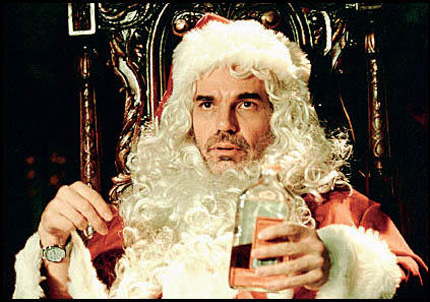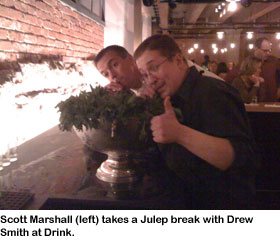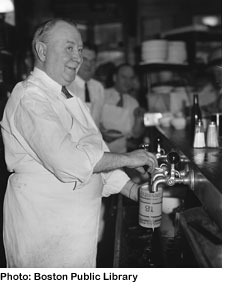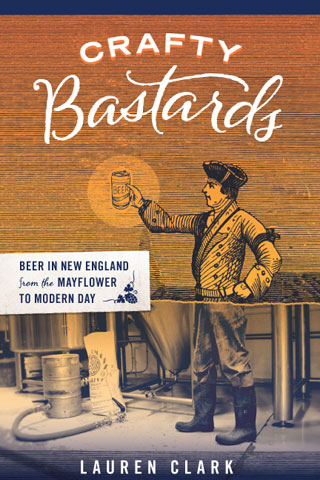December 25th, 2010

Imbibers, I hope you got that rare rye whiskey, vintage ice shaver or custom-sculpted muddler you wanted for Christmas. I got the recipe for Silent Night Punch from my friend Pink Lady of LUPEC Boston and warmed the cheeks of my loved ones in New Hampshire with it. Fa la la la la. La la la la. If you find yourself reaching deep into the toe of your Christmas stocking for that one last knick-knack you may have missed, Bad Santa has got you covered. May the following virtual goodies souse up your Christmas night:
Drinkboston mobile. Got an iPhone, Android, Blackberry or some other kind of smart phone? You can now use it to check out drinkboston without having to wait for the full site to load, ’cause I got a sweet new mobile version! You can save an icon on your homescreen, and sharing posts via Facebook, Twitter, etc is a breeze. Bars, bartenders and imbibing in Beantown just got a whole lot more excellent.
Vermouth 101. “The intent of these pages is to demystify vermouth, primarily for the American audience.” From Martin Doudoroff, one half of the team that made every cocktailero’s life easier with CocktailDB, comes a much-needed primer on this misunderstood cocktail staple. (Supporting roles played by Eric Seed, Romée de Gorianoff and Alexandre Vingtier.) Thank you, gentlemen, from the bottom of our livers.
Tiki+ app. The CocktailDB team also presents, in partnership with Jeff “Beachbum” Berry, the newly updated Tiki+ app. One hundred and fifty top-notch, vintage and contemporary tiki recipes, plus pretty pictures, for $3.99. Don’t be a suffering bastard — download yours today!
2010 Devil’s Dining Awards. MC Slim JB distills the best, worst and otherwise most memorable items from the year in dining (and drinking) into this wickedly smart, funny list. In my book, Slim is the best food writer in Boston.
Now… what are you doing New Year’s Eve?
Tags: apps, Martin Doudoroff, MC Slim JB, tiki
Posted in Books & resources, Nips, Vermouth | 5 Comments »
May 14th, 2009
 This installment of Nips is all about congratulations. First, congrats to bartender Scott Marshall of Drink, who earned the highest score on last week’s BarSmarts Advanced exam in Boston.
This installment of Nips is all about congratulations. First, congrats to bartender Scott Marshall of Drink, who earned the highest score on last week’s BarSmarts Advanced exam in Boston.
BarSmarts Advanced is a new spirits and mixology training and certification program run by Beverage Alcohol Resource (BAR) and Pernod Ricard. You may recall that two other Drink bartenders, Misty Kalkofen and Josey Packard, have passed the rigorous BAR 5-Day Program in New York City. Roughly speaking, BarSmarts Advanced is to BAR 5-Day as the SATs are to college. And, just as some students get scholarships for acing the SATs, Marshall’s high score earned him a $3,500 scholarship to attend BAR 5-Day this fall. About 100 bartenders and related industry folk from around New England participated in the BarSmarts Advanced course, which is being offered in cities throughout the U.S. One of those related industry folk was yours truly. And yes, I passed. More about BarSmarts in another post.
Speaking of Josey Packard, congrats to her for making the Improper Bostonian’s annual Beloved Bartenders issue. Don’t worry, Josey, we still respect you.
Congrats to Fred Yarm of cocktail virgin slut for being named a finalist in the TRU Organic Spirits Barmade Bitters Challenge. In July, Yarm will present his celery bitters to a panel of judges at Tales of the Cocktail in New Orleans in hopes of becoming one of three winning mixologists to see their recipes commercialized. Go, Fred!
Finally, congrats to Boston food/drink critic and drinkboston contributor MC Slim JB for recently launching a kick-ass blog. You know his stellar prose from the Phoenix, stuff@night, Boston Magazine, etc., and now you can enjoy the type of commentary that doesn’t adhere to the polite, hook-driven strictures of our mainstream press.
Tags: BAR, BarSmarts Advanced, Beverage Alcohol Resource, Fred Yarm, josey packard, MC Slim JB
Posted in Bitters, Books & resources, Nips | 7 Comments »
January 12th, 2009
 An interview with Misty Kalkofen
An interview with Misty Kalkofen
By MC Slim JB
Boston bartender Misty Kalkofen recently became one of the few bartenders in the country to be certified by the Beverage Alcohol Resource (BAR). If you’re not in the hospitality industry, you can be forgiven for not knowing what a huge deal that is. Think of it as being named a Rhodes Scholar or a MacArthur Fellow for your work with a shaker and your deep understanding of spirits, cocktail culture and history. It takes a lot of training, serious study and the ability to pass a gut-wrenching examination with both lab work and written exercises.
The credential is relatively new. While wine professionals have been able to pursue Master Sommelier diplomas for decades, and chefs their culinary-school degrees for centuries, bartenders have had little to prove their skills other than their following. That changed in 2006, when a group of the industry’s brightest luminaries founded the BAR in New York City to train and certify cocktail professionals. Its faculty features some of the heaviest hitters in the business, including F. Paul Pacult, editor of Spirit Journal; Dale DeGroff, famed mixologist and founder of the Museum of the American Cocktail; Steven Olson, noted wine and spirits writer and educator; Doug Frost, a rare Master Sommelier and Master of Wine; David Wondrich, famed cocktail historian and correspondent for Esquire, and Andy Seymour of aka wine geek.
Ms. Kalkofen took the BAR’s five-day Intermediate course (tuition: $3,500), and by passing the grueling exam received the greater of the two levels of certification, BAR-Ready, which recognizes professional-level bartending skills in high-intensity environments, plus broad knowledge of the culture, history and makeup of spirits and cocktails. (The lesser credential, BAR-Certified, requires more modest bartending skills.) Her resume already reads like a greatest hits of serious Boston bars: she’s currently at Drink, Boston’s newest temple to Golden Age cocktails (her Drink colleague Josey Packard is the only other Boston bartender to be BAR-certified); she previously managed the bar at Green Street, another of Boston’s three or four best; and she’d worked a long stint at the bygone B-Side Lounge, the birthplace of Boston’s cocktail revival. I sat down with her to ask her about her work and her experience with the BAR exam.
MC Slim JB: Was the B-Side your first stint behind the bar?
Misty Kalkofen: Nope. My first bar gig was at the Lizard Lounge. That is also where I met Brother Cleve, who was instrumental in starting me down the road of cocktail lover/historian/geek! He did a weekly DJ night called Saturnalia, and each week he would teach me a classic cocktail recipe. After two years of Thursday nights, I had this nice catalog of delicious classic recipes in my noggin, and I was hooked!
MC: So what was your motivation for taking the BAR exam? Professional pride? Bragging rights with your peers? Career opportunities?
MK: I’d heard a lot about the BAR and had been interested in it for a while. Obviously, all one needs to do is read the bios of the instructors to realize that you will learn soooo much. And in any profession, if you stop learning, you stop growing, and the rest of the industry will pass you by. So the educational side was a huge draw for me. Also, I knew I would meet folks from all over the country who are interested in the same things I am. I love having people to talk to about ideas and trends, so the more bartenders and brand ambassadors I can meet the better!
MC: Tell me about the exam. I’ve heard it’s more stressful than the SATs and GREs combined. What are the different components?
MK: The exam consists of three parts. In the practical phase, they set up a faux bar situation in the kitchen of the Astor Center and took us in six at a time to make drinks. We were evaluated by two people: one instructor and one BAR graduate. They approached us as guests and started ordering drinks. We had to make six drinks, and were evaluated on technique, knowledge and our ability to make the drinks correctly and deliciously in the allotted time.
Part two was the tasting phase. First, we had to blind-taste two variations of the same cocktail and compare them. The point wasn’t to name the drink, but to contrast the two, saying which was more balanced and why. Next, we had to blind-taste six spirits. For each we filled out an evaluation sheet on which we had to list all the aspects of the spirit’s taste, both generally and specifically.
For example, I would mark the box for “tropical fruits,” but I would then need to write down which specific tropical fruits, e.g., coconut or banana. We assessed for fruit, non-fruit (flowers, herbs, spices, vegetables), wood and aging — for example, what notes (such as butterscotch or pepper) hint at barrel aging, what type of wood the spirit was aged in and for how long. We were also asked to estimate proof and to evaluate cleanliness, balance, oak integration, length of finish, complexity and quality. Finally, we had to identify what the spirit was made from, where, and what category it falls into. You could get extra credit for naming brands, a specific region of origin, etc.
Part three was a written exam: about a hundred true/false, multiple choice, short answer and essay questions. Then I had to critique a cocktail menu.
MC: Yikes! So, what drinks did you have to make?
MK: Four were from a list of the most important/common drinks from the manual that we’d been studying. For number five, I had to buy a spirit from Astor Wine and Spirits, make an infusion from it, and then create a cocktail based on the infusion. It could be something I’d worked with before or something new — it was up to me. The final cocktail was my choice. I made my evaluators (Don Lee of New York’s high-craft speakeasy PDT and Willy Shine of the BAR) a Hearst for my chosen cocktail. Interestingly enough, on the night before the exam, at a dinner in Chinatown, I predicted that Don Lee would be one of my evaluators and that I would make him a Hearst. Perhaps I missed my true calling: fortune teller!
MC: How cool! I’m dying to get to PDT. Do you remember the spirits in the blind tasting?
MK: Well, an answer to that would be pure speculation, as we never get a corrected copy of our exam back. The interesting thing about the blind tasting is that you could evaluate a spirit correctly as far as taste descriptors and aging evaluations were concerned and receive many points, while still arriving at the wrong conclusion as far as a spirit family was concerned.
MC: Sounds like my college topology course. What was the scariest part of the exam?
MK: Hmmm … well, making drinks in the practical phase was nerve-wracking because the setup was unfamiliar, and I was making drinks for two people that I have the utmost respect for in this field. But I was most nervous about the blind tasting. Even in an unfamiliar situation I feel confident in my mixing skills, but the finer points of tasting were new to me. Many of the other folks in the course had amazing palates and also had more background in the proper way to taste spirits, so the group tastings could be a bit intimidating and overwhelming.
MC: You’re a well-educated person: you’ve taken your share of other standardized tests. Were you one of those kids that slayed the SATs? Do you remember your scores?
MK: I don’t. I know my parents were psyched by them, but I have no recollection of what they actually were …
MC: Baloney! You’re just being modest, Ms. Smarty-Pants! So, did you come out of the BAR exam thinking, “Pish, I nailed it,” or were you on tenterhooks waiting for the envelope to deliver your fate?
MK: I didn’t breathe for weeks. I was so frickin’ nervous. Even after I found out I passed I didn’t believe it.
MC: How did you celebrate?
MK: I drank a couple big bowls of punch with the ladies of LUPEC [Ladies United for the Preservation of Endangered Cocktails] and our great supporters at Grand at the first LUPEC punch party!
MC: I’ve seen the photos; that one looked like a lulu! Is there a diploma on your wall now, or do they just teach you a secret handshake? Do you get to put extra letters after your name on your business card?
MK: I wish there was a secret handshake — I think I’ll bring that up. As far as the extra letters, I don’t think there is anymore room after the four already there: l.u.s.h.
MC: So does membership have its privilege, like better shifts? Can you ignore [Drink bar manager] John Gertsen’s advice now? Must your colleagues now refer to you as Madame Bartender or Queen of the Stick?
MK: Queen of the Stick — I like that one! Honestly, it just pushes me to stay on top of my game. Colleagues and coworkers come to me with questions because I’ve taken the course and I want to represent well. So I spend a lot of time with my head in the books reviewing materials and learning more!
MC: Any advice for would-be BAR exam takers?
MK: Start testing yourself on spirits. It doesn’t necessarily need to be blind, but taste ingredients outside of cocktails. Unfortunately that’s not something most bartenders frequently do unless they deal with purchasing. And read everything you can get your hands on.
MC: As a longtime fan of your bartending and hospitality skills, let me say thanks for taking the time to talk with me, and congratulations on your remarkable achievement!
MK: My pleasure!
Guest blogger MC Slim JB is a Boston-based writer whose restaurant reviews and food/drink features have appeared in Boston Magazine, the Boston Phoenix, stuff@night, and the Weekly Dig. MC is also a frequent contributor to the restaurant review website Chowhound.
Tags: MC Slim JB, Misty Kalkofen, mixology course
Posted in Bartenders | 9 Comments »
February 9th, 2008

By MC Slim JB
With this post, drinkboston introduces a new guest contributor, MC Slim JB. MC is a Boston-based writer whose honest, sharp restaurant reviews and food/drinks features have appeared in Boston Magazine, the Boston Phoenix, stuff@night, and the Weekly Dig. MC is also a frequent contributor to the restaurant review website Chowhound.
As a cocktail lover, I often sing the praises of my favorite bartenders’ technical chops: their ability to assemble well-balanced cocktails with speed and precision from the best and freshest ingredients, and to serve them with the right garnish, in the right glass, at the right temperature. But those skills are learnable. With enough training and practice, just about anybody can do those things well. A less transferable skill is the hospitality aspect of bartending, the person behind the stick’s ability to make each customer feel welcome, comfortable and well cared for.
I tried to think of a few small things that my favorite bartenders do that make me happy about my experience in their bars, and — having gotten accustomed to this kind of hospitality — that make me unhappy in places that don’t do them. Here are a few:
1. Acknowledge my presence with a word, a look or a nod when I first walk up to the bar. This way I know, even when it’s crazy-busy, that you’ll eventually get to me. That tiny bit of reassurance that I haven’t been lost in the crowd or deliberately ignored makes a big first impression.
2. Take the time, if you can spare it, to share my love of fine cocktails by talking with me about them. I love to hear more about the drink you’ve made me, the spirits and other ingredients that go into it, interesting variations on it, the lore and history surrounding it, who else makes a great one in town, suggestions for other cocktails you think I might like. I want my bartenders to share my fascination with cocktails and to be scholarly and passionate about their work, not just mechanics on an assembly line. (And for my friends who don’t care about that stuff, make and serve their drinks without fanfare or foofaraw.)
3. If I’m by myself, facilitate some interaction with other patrons. Share a story, talk up the game on the TV, make an introduction. Drinking isn’t much fun as a solitary sport, but not everyone is at ease striking up conversations with strangers, especially when traveling or in an unfamiliar venue. The bartender is in a unique position to bridge those social gaps, to help solo patrons feel a little less lonely and, incidentally, to offload some of the burden of entertaining them and so better tend to other customers.
4. When it’s time for me to go, give me an accurate check and bring my change or credit slip promptly. This is my last impression of your service before I leave a tip. It’s a good step to execute crisply.
There are hundreds of other little things that get bartenders onto my “awesome” list. Although thousands of people pass through his bar, Rob at the B-Side manages to remember my usual, even when I haven’t been by in months. No matter how busy it is at the bar at No. 9 Park, John always shakes my rye flip for five minutes. (Try this with a full shaker sometime to see how much work it is.) At Sasso, Casey invariably finds a way to get a conversation going between me and the rest of the bar. Every time I go by Green Street, Dylan has some innovative new concoction he’s itching to pour for me while expounding on its backstory. Sure, these folks are all great cocktail technicians, but it’s the way they make me feel like an important customer that inspires my loyalty. That’s what makes throngs of devotees follow them wherever they work. Hospitality skills are what separate the merely competent bartenders from the great ones.
Tags: MC Slim JB
Posted in Bartenders | 9 Comments »

 This installment of
This installment of 

